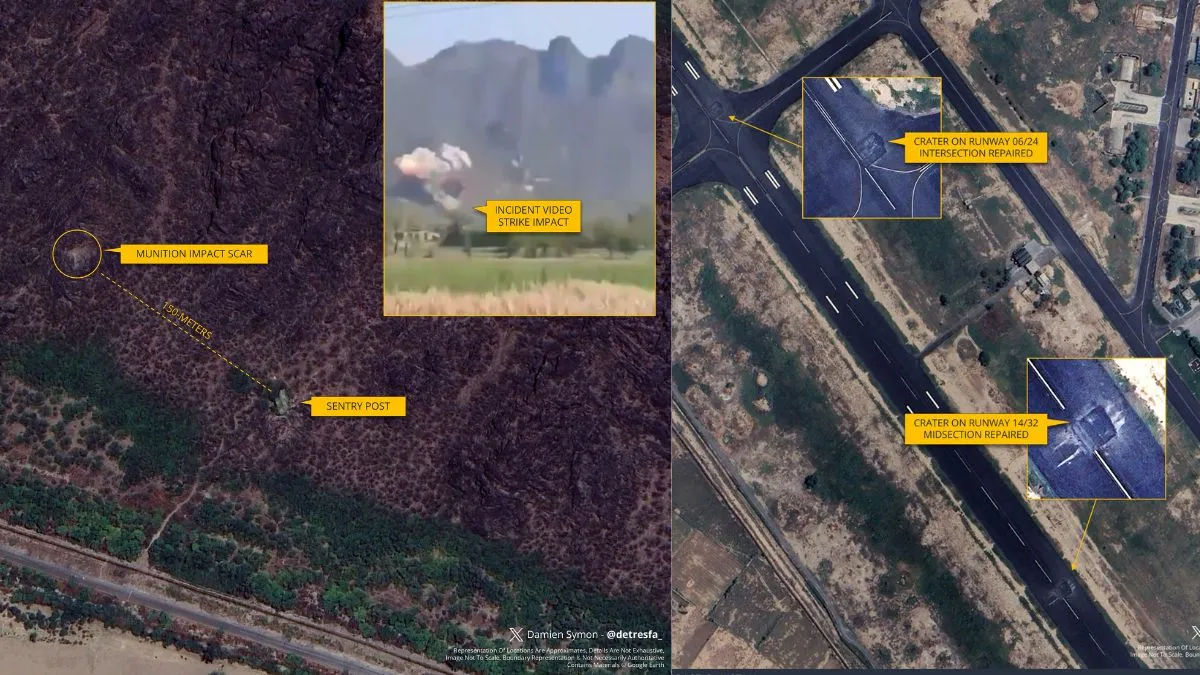- By Supratik Das
- Sun, 20 Jul 2025 08:38 AM (IST)
- Source:JND
In a significant development, new satellite photos have emerged suggesting a suspected missile attack on Pakistan's Kirana Hills, a site linked to the country’s nuclear weapons programme during Operation Sindoor in May 2025. The satellite data, provided and interpreted by geo-intelligence analyst Damien Symon, reveals a visible impact zone in Pakistan's Sargodha region and recently repaired airstrips at the Sargodha airbase, suggesting damage from India Air Force's precision airstrikes.
Indian Forces Denying, but Pictures Say Otherwise
The emergence of this evidence comes nearly two months after the Indian government and the IAF categorically denied targeting the Kirana Hills, a heavily fortified area believed to house underground nuclear storage and research facilities. In a May 12 press conference, Director General of Air Operations Air Marshal AK Bharti dismissed the accusation with a hint of a smile, declaring: "Thank you for informing us that Kirana Hills has some nuclear facilities. We were not aware of that. We have not attacked Kirana Hills." But the recently re-analysed satellite imagery denies this official line, and raises new questions about what was the extent and what were the targets of Operation Sindoor.
India initiated Operation Sindoor on May 10 to avenge the deadly terror strike in Jammu and Kashmir's Pahalgam, which killed 26 innocent civilians. The Indian Air Force is said to have used up to 15 BrahMos missiles and other high-accuracy weapons in the midnight operation, targeting important Pakistani military assets.
One of Symon’s images shows newly repaired runways at the Sargodha airbase (now known as Mushaf airbase). The speed of the restoration work suggests that the airbase remains a high-value strategic asset for Pakistan’s military operations. The Kirana Hills area, just near the airbase, is said to house radar stations, tunnels, and installations linked to Pakistan's much-debated nuclear programme, including subcritical nuclear tests in the 1980s. When questioned on X if the missile attack represents a direct hit at a storage of nuclear materials or an entrance to the tunnels, Symon explained: "No, this, with previous imagery, neither suggests any underground impact nor penetration. It's merely one side of a hill with nothing of any particular worth. It must've been a warning attack. The tunnels are at a distance and don't present any damage."
Imagery update from Google Earth of the Sargodha region, Pakistan, captured in June 2025, shows -
— Damien Symon (@detresfa_) July 18, 2025
1 - the impact location of India's strike on Kirana Hills in May 2025
2 - repaired runways at Sargodha airbase post India's strikes in May 2025 pic.twitter.com/BLOXYB9fKP
Thus far, Pakistan has neither confirmed nor denied the alleged impact site. Islamabad still maintains the Sargodha airbase partially shut down, again prolonging flight restrictions within the region, a measure analysts interpret as further proof of damage and heightened alert status.
ALSO READ: 'Five Jets Downed, But We Stopped War': Trump’s Big Claim Ignites India-Pakistan War Debate Again
In a separate development, satellite analyst Symon previously also discredited Pakistan's report of the destruction of India's Adampur airbase and a Su-30MKI and S-400 system. Satellite imagery in March 2025 revealed routine maintenance activity. Post-conflict, Prime Minister Narendra Modi went to Adampur and stood with IAF personnel and an S-400 battery behind him, emphasizing that there had been no damage. With fresh satellite images promising the true extent of Operation Sindoor, the incident constitutes one of the most extreme escalations between India and Pakistan in recent years.

